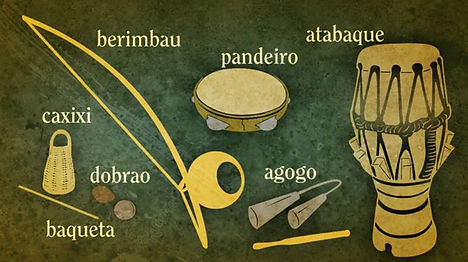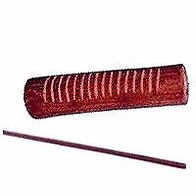
CAPOEIRA MUSIC & DANCING

History of Capoeira and It's Music
Capoeira is an art form that involves movement, music, and elements of practical philosophy. One experiences the essence of capoeira by "playing" a physical game called jogo de capoeira (game of capoeira) or simply jogo. (Capoeira.bz) It was created by African slaves who were brought to brazil.Portuguese colonists created large sugarcane farms called calledengenhos, which depended on the labor of slaves. Slaves, living in inhumane and humiliating conditions, were forced to work hard and often suffered physical punishment for small misbehaviors. Although slaves often outnumbered colonists, rebellions were rare due to lack of weapons, harsh colonial law, disagreement between slaves coming from different African cultures and lack of knowledge about the new land and its surroundings usually discouraged the idea of a rebellion.
In this environment, capoeira was born as a simple hope of survival. Prohibited from celebrating their cultural customs and strictly forbidden from practicing any martial arts, capoeira is thought to have emerged as a way to bypass these two imposing laws. Hidden in the musical and rhythmical elements of the form, violent kicks were disgusted as passionate dance movements, and its combination of a mixture of West African cultures saved it from being identified as an attempt to preserve any specific tradition.
Music is integral to Capoeira. It sets the tempo and style of game that is to be played within the roda or the circle. Typically the music is formed by instruments and singing. Rhythm, controlled by a typical instrument called berimbau, differ from very slow to very fast, depending on the style of the roda.
Capoeira instruments are disposed in a row called bateria. It is traditionally formed by three berimbaus, two pandeiros, one atabaque, one agogô and one ganzá, but this format may vary depending on the Capoeira group’s traditions or the roda style.
The berimbau is the leading instrument, determining the tempo and style of the music and game played. Two low pitch berimbaus (called berra-boi and médio) form the base and a high pitch berimbau (called viola) makes variations and improvisations. The other instruments must follow the berimbaus rhythm,
as the capoeiristas change their playing style significantly following the toque of the berimbau, which sets the game’s speed, style and aggressiveness, it is truly the music that drives a Capoeira game.
There are four basic kinds of songs in capoeira, the Ladaínha, Chula, Corrido and Quadra. The Ladaínha is a narrative solo sung only at the beginning of a roda, often by a mestre (master) or most respected capoeirista present. The solo is followed by a a call and response pattern that usually thanks God and one’s master, among other things. Each call is usually repeated word-for-word by the responders. The Chula is a song where the singer part is much bigger than the chorus response, usually eight singer verses for one chorus response, but the proportion may vary. The Corrido is a song where the singer part and the chorus response are equal, normally two verses by two responses. Finally, the Quadra is a song where the same verse is repeated four times, either three singer verses followed by one chorus response, or one verse and one response. (Draculinho Wordpress)
Capoeira songs can talk about virtually anything, being it about a historical fact, a famous capoeirista, trivial life facts, hidden messages for players, anything. Improvisation is very important also, while singing a song the main singer can change the music’s lyrics, telling something that’s happening in or outside the Roda.

Berimbau
The berimbau is a musical bow of African origin. It consists of an arc of biriba wood about 1.6 meters long and 2.5 centimeters thick, called the verga. The lower end of the verga is carved into a peg to attach the wire (arame), which is then stretched tight over the top end of the verga, bending it.
Pandeiro
Pandeiro The pandeiro, originally from East Africa, is a type of tambourine. The instrument’s head may be made of leather, snakeskin, or plastic. Capoeira, samba, reggae, and many other forms of Brazilian music utilize this instrument.
Atabaque
The atabaque is a tall hand drum. The body is typically made of jacaranda wood and the head, fastened to the body by ropes, of calfskin. The atabaque maintains the beat and secures the pace of the rhythm being played in the roda. There are three sizes of this instrument: rum (the tallest with the lowest sound), rum-pi (medium height and medium sound) and lê (shortest with the highest sound). Multiple atabaques are used in maculelê and in candomblé ceremonies, but the capoeira roda uses only one.
Agogô
The agogô is an African musical instrument whose name means “bell.” It consists of two hollow iron cones that are struck with a stick.
Reco-reco
The reco-reco is a section of bamboo with notches cut into the side; it is played by rubbing a stick back and forth over the grooves. The reco-reco is believed to originate from the indigenous peoples of Brazil. It is also used in samba and reggae.




